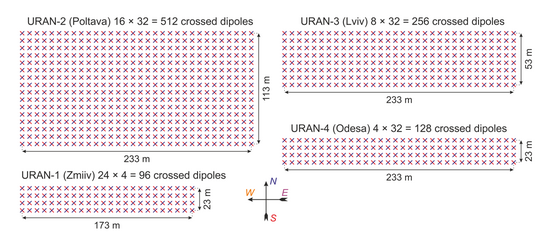URAN
Topic: Astronomy
 From HandWiki - Reading time: 2 min
From HandWiki - Reading time: 2 min
URAN (Ukrainian Radio Interferometer of NASU)[1] (Ukrainian: Український Радіоіонтеферометр Академії Наук - УРАН) is an array of radio-telescopes, spread across Ukraine and used for long-baseline interferometry in the 8-40 MHz range. The most sensitive of the telescopes is UTR-2; URAN-1 (built in 1975 in Zmiiv (Kharkiv oblast) ) and URAN-2 (construction started in 1979 in Stepanivka village near Poltava), URAN-3 is near Shatsk, in the north-west corner of Ukraine by the point where Poland and Belarus meet Ukraine, and URAN-4 (built in 1975) is in the south-west, a little west of Odesa and by the Moldovan border.
Auxiliary telescopes are URAN-1 has 96 dipoles in a 178 x 28m array; URAN-2 has 512 in a 238 x 118m; URAN-3 has 256 in a 238 x 58m; URAN-4 has 128 in 238 x 28m. Because of the small number of baselines, images from URAN tend to be produced by model-fitting to sums of Gaussians rather than by direct synthesis.
URAN low-frequency VLBI system, UTR-2 and GURT radio telescopes on the map of Ukraine .
References
- ↑ Konovalenko, A.; Sodin, L.; Zakharenko, V.; Zarka, P.; Ulyanov, O.; Sidorchuk, M.; Stepkin, S.; Tokarsky, P. et al. (2016-04-28). "The modern radio astronomy network in Ukraine: UTR-2, URAN and GURT" (in en). Experimental Astronomy 42 (1): 11–48. doi:10.1007/s10686-016-9498-x. ISSN 0922-6435. Bibcode: 2016ExA....42...11K.
Most of the information in this article comes from Valeriy Shepelev's presentation http://www.lofar.org/workshop/26Apr07_Thursday03/LOFARWorkshop_Apr07_ValeriyShepelev.pdf at an April 2007 LOFAR workshop.
Further reading
- S. Y. Braude; B. A. Dubinskii; N. L. Kaidanovskii; N. S. Kardashev; M. M. Kobrin; A. D. Kuzmin; A. P. Molchanov; Yu. N. Pariiskii et al. (2012). A Brief History of Radio Astronomy in the USSR: A Collection of Scientific Essays. Springer Science & Business Media. p. 193. ISBN 978-94-007-2834-9. https://books.google.com/books?id=e6NDa-5VHNYC&pg=PA193.
 |
 KSF
KSF

